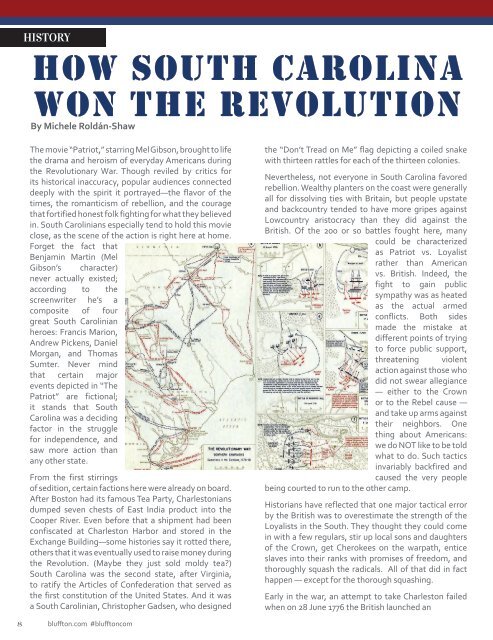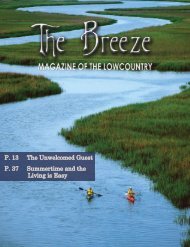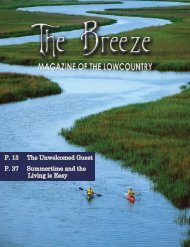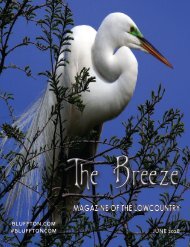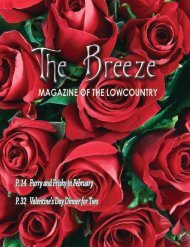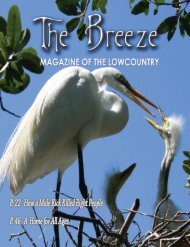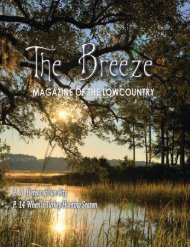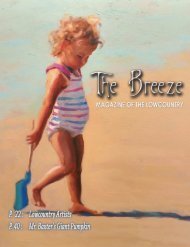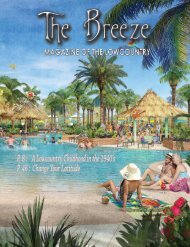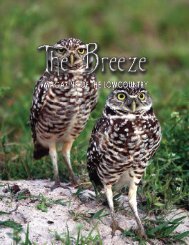You also want an ePaper? Increase the reach of your titles
YUMPU automatically turns print PDFs into web optimized ePapers that Google loves.
HISTORY<br />
How South Carolina<br />
Won <strong>the</strong> Revolution<br />
By Michele Roldán-Shaw<br />
<strong>The</strong> movie “Patriot,” starring Mel Gibson, brought to life<br />
<strong>the</strong> drama and heroism <strong>of</strong> everyday Americans during<br />
<strong>the</strong> Revolutionary War. Though reviled by critics for<br />
its historical inaccuracy, popular audiences connected<br />
deeply with <strong>the</strong> spirit it portrayed—<strong>the</strong> flavor <strong>of</strong> <strong>the</strong><br />
times, <strong>the</strong> romanticism <strong>of</strong> rebellion, and <strong>the</strong> courage<br />
that fortified honest folk fighting for what <strong>the</strong>y believed<br />
in. South Carolinians especially tend to hold this movie<br />
close, as <strong>the</strong> scene <strong>of</strong> <strong>the</strong> action is right here at home.<br />
Forget <strong>the</strong> fact that<br />
Benjamin Martin (Mel<br />
Gibson’s character)<br />
never actually existed;<br />
according to <strong>the</strong><br />
screenwriter he’s a<br />
composite <strong>of</strong> four<br />
great South Carolinian<br />
heroes: Francis Marion,<br />
Andrew Pickens, Daniel<br />
Morgan, and Thomas<br />
Sumter. Never mind<br />
that certain major<br />
events depicted in “<strong>The</strong><br />
Patriot” are fictional;<br />
it stands that South<br />
Carolina was a deciding<br />
factor in <strong>the</strong> struggle<br />
for independence, and<br />
saw more action than<br />
any o<strong>the</strong>r state.<br />
From <strong>the</strong> first stirrings<br />
<strong>of</strong> sedition, certain factions here were already on board.<br />
After Boston had its famous Tea Party, Charlestonians<br />
dumped seven chests <strong>of</strong> East India product into <strong>the</strong><br />
Cooper River. Even before that a shipment had been<br />
confiscated at Charleston Harbor and stored in <strong>the</strong><br />
Exchange Building—some histories say it rotted <strong>the</strong>re,<br />
o<strong>the</strong>rs that it was eventually used to raise money during<br />
<strong>the</strong> Revolution. (Maybe <strong>the</strong>y just sold moldy tea?)<br />
South Carolina was <strong>the</strong> second state, after Virginia,<br />
to ratify <strong>the</strong> Articles <strong>of</strong> Confederation that served as<br />
<strong>the</strong> first constitution <strong>of</strong> <strong>the</strong> United States. And it was<br />
a South Carolinian, Christopher Gadsen, who designed<br />
<strong>the</strong> “Don’t Tread on Me” flag depicting a coiled snake<br />
with thirteen rattles for each <strong>of</strong> <strong>the</strong> thirteen colonies.<br />
Never<strong>the</strong>less, not everyone in South Carolina favored<br />
rebellion. Wealthy planters on <strong>the</strong> coast were generally<br />
all for dissolving ties with Britain, but people upstate<br />
and backcountry tended to have more gripes against<br />
<strong>Lowcountry</strong> aristocracy than <strong>the</strong>y did against <strong>the</strong><br />
British. Of <strong>the</strong> 200 or so battles fought here, many<br />
could be characterized<br />
as Patriot vs. Loyalist<br />
ra<strong>the</strong>r than American<br />
vs. British. Indeed, <strong>the</strong><br />
fight to gain public<br />
sympathy was as heated<br />
as <strong>the</strong> actual armed<br />
conflicts. Both sides<br />
made <strong>the</strong> mistake at<br />
different points <strong>of</strong> trying<br />
to force public support,<br />
threatening violent<br />
action against those who<br />
did not swear allegiance<br />
— ei<strong>the</strong>r to <strong>the</strong> Crown<br />
or to <strong>the</strong> Rebel cause —<br />
and take up arms against<br />
<strong>the</strong>ir neighbors. One<br />
thing about Americans:<br />
we do NOT like to be told<br />
what to do. Such tactics<br />
invariably backfired and<br />
caused <strong>the</strong> very people<br />
being courted to run to <strong>the</strong> o<strong>the</strong>r camp.<br />
Historians have reflected that one major tactical error<br />
by <strong>the</strong> British was to overestimate <strong>the</strong> strength <strong>of</strong> <strong>the</strong><br />
Loyalists in <strong>the</strong> South. <strong>The</strong>y thought <strong>the</strong>y could come<br />
in with a few regulars, stir up local sons and daughters<br />
<strong>of</strong> <strong>the</strong> Crown, get Cherokees on <strong>the</strong> warpath, entice<br />
slaves into <strong>the</strong>ir ranks with promises <strong>of</strong> freedom, and<br />
thoroughly squash <strong>the</strong> radicals. All <strong>of</strong> that did in fact<br />
happen — except for <strong>the</strong> thorough squashing.<br />
Early in <strong>the</strong> war, an attempt to take Charleston failed<br />
when on 28 June 1776 <strong>the</strong> British launched an<br />
8<br />
bluffton.com #blufftoncom


